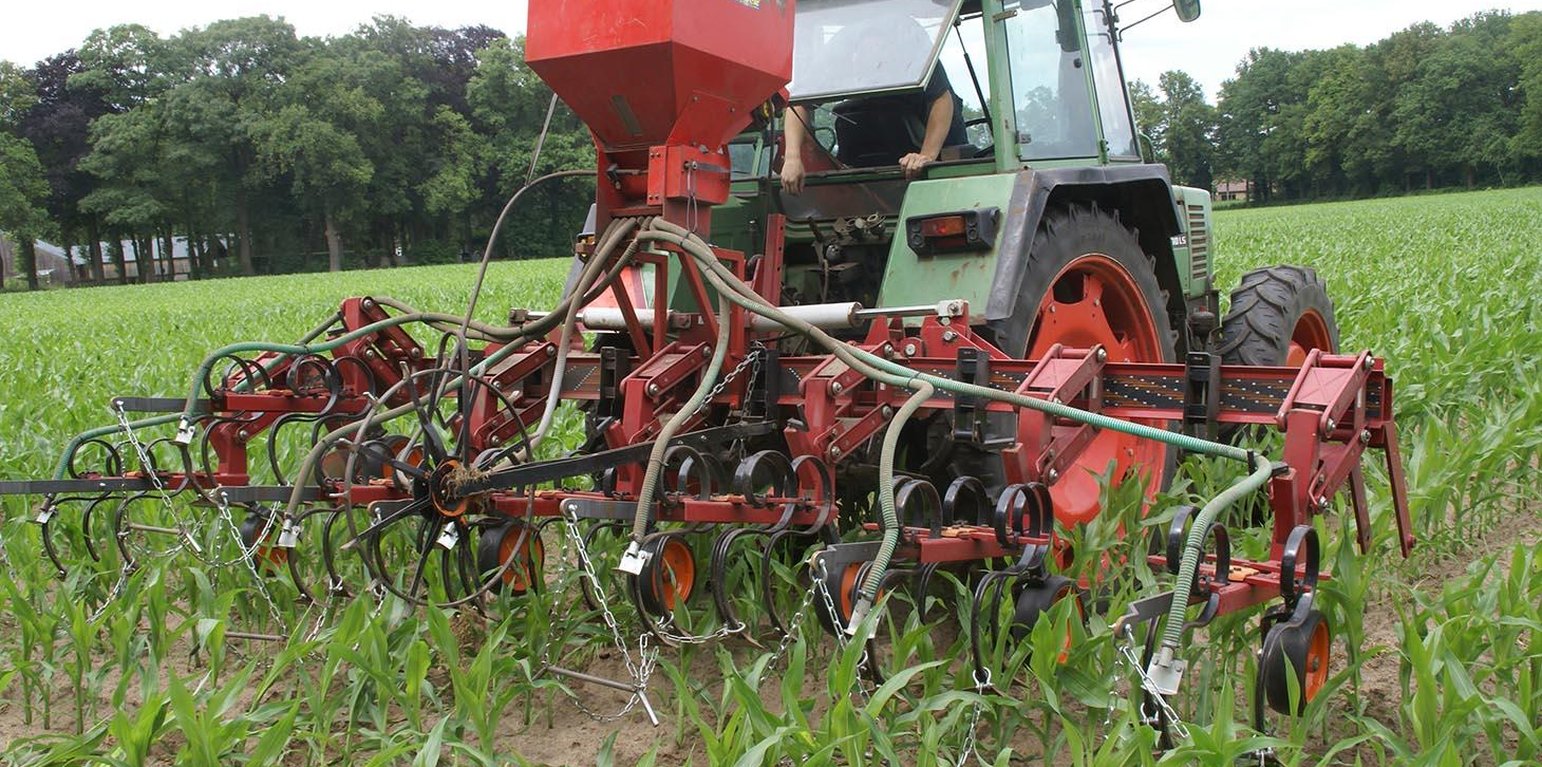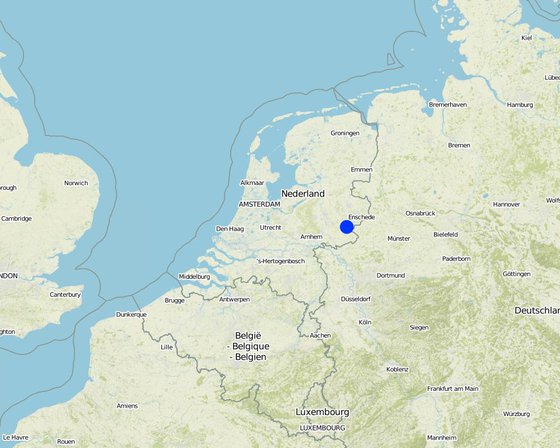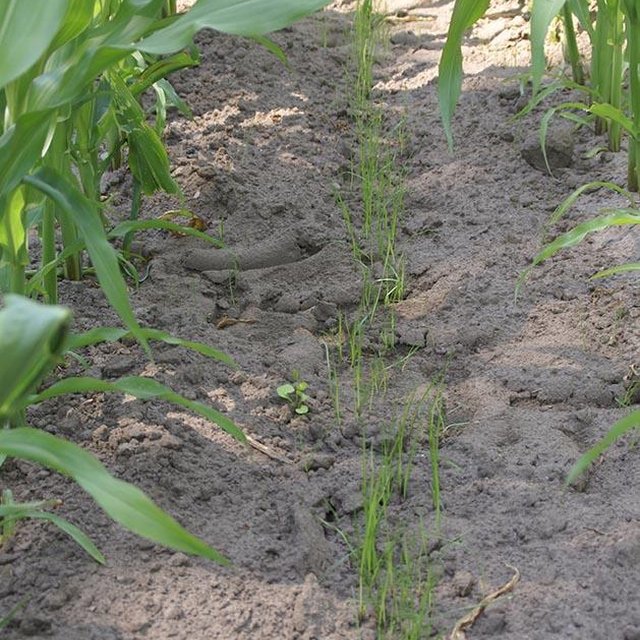



Italian rye grass is sown when the corn has grown to knee height, and has not yet developed a closed cover. The grass is plowed into the soil several months after the harvest of the corn crop.
Purpose of the Technology: The purpose of the technology is to enable a good growth of the catch crop (the grass) and to increase root biomass production after the corn is harvested. This will contribute to the organic mater content of the soil, and reduce the leaching of nitrogen and potassium. After underplowing of the grass, the nitrogen and potassium will be released to the soil and become available for the next crop.
Establishment / maintenance activities and inputs: When corn is well established (between 30-60 cm height), grass is seeded between rows. A special seeder is required. Tractor must have tires that fit between corn rows. Grass germinates, but growth is reduced as corn matures and creates shade. When corn is harvested, grass continues to grow as a winter catch-crop. Some years, grass is sprayed with fertiliser to increase mineralisation. Grass is cultivated into the soil in early spring.
Natural / human environment: Multi-functional rural area with land use for agriculture, recreation, residence and nature. Dairy agriculture in small farms for Dutch standards combined with arable cropping. High livestock density.
Undulating landscape with cover sands and clayey and loamy sediments. Podzols and cambisols developed in sandy substrate. The area also has patches of anthroposols, soils enriched in Medieval times with manure and organic residues. Phosphate and nitrogen levels in these soils are in general high.
Mean monthly temperature varies between 2 and 17°C. The long-term mean annual precipitation is between 800 and 825 mm, with the lowest amounts in spring, and the highest in autumn. The long-term average annual precipitation deficit is between 200 and 240 mm.

Location: Haarlo - Oude Eibergen, Gelderland, Netherlands
No. of Technology sites analysed:
Spread of the Technology: evenly spread over an area (0.94 km²)
In a permanently protected area?:
Date of implementation: less than 10 years ago (recently)
Type of introduction







| Specify input | Unit | Quantity | Costs per Unit (Euro) | Total costs per input (Euro) | % of costs borne by land users |
| Equipment | |||||
| Seeder | Machine | 1.0 | 5327.05 | 5327.05 | |
| Total costs for establishment of the Technology | 5'327.05 | ||||
| Total costs for establishment of the Technology in USD | 5'667.07 | ||||
| Specify input | Unit | Quantity | Costs per Unit (Euro) | Total costs per input (Euro) | % of costs borne by land users |
| Equipment | |||||
| Machine use | ha | 1.0 | 117.2 | 117.2 | 100.0 |
| Plant material | |||||
| Seeds | ha | 1.0 | 42.62 | 42.62 | 100.0 |
| Fertilizers and biocides | |||||
| Fertilizer Hired(machine+fert) | ha | 1.0 | 9.06 | 9.06 | 100.0 |
| Total costs for maintenance of the Technology | 168.88 | ||||
| Total costs for maintenance of the Technology in USD | 179.66 | ||||
Expected increase of maize production: to 6-7 tonnes/ha. Not proven yet.
Possible competition between crop and grass. Not shown yet.
Expected. Not proven yet.
Only for farmers with fields at higher elevations and drier soils.
Saves seeding winter crop in autumn.
Added planning, but work is hired.
Undersowing of grass in the standing maize crops requires specific skills.
Created farmer's foundation.
Farmers understanding ecological impacts of farming practices and organic matter in soils.
Farmers collaborating with water company.
Dairy farmers have learned more about the importance of soil organic matter for their production systems, and about the consequences of soil management on soil organic matter and other aspects of soil health. This learning was brought by the exchange of knowledge between farmers and experts, and between farmers themselves. Farmers also profited from services provided to them by the farmers' foundations: shared investments (e.g. in the manure separator) and support in the application for subsidies to finance the SLM measure.
Insignificantly more water transpiration.
Expected. Not proven yet.
Expected. Not proven yet. Little to no slope.
Expected. Not proven yet.
Insignificantly more water transpiration.
Expected. Not proven yet. Claimed by some farmers already.
Not measured but observed on photographs.
Expected. Not proven yet.
Expected. Not proven yet.
Not measured but observed on photographs.
Expected. Not proven yet.
Possibly. Not proven.
Expected. Not proven yet.
Expected. Not proven yet.
Expected. Not proven yet.
Expected. Not proven yet.